The old adage, “The pen is mightier than the sword” is an absolute truth. Stories—told through words and music—can transform lives; they can change minds; they can educate the reader on new topics; they can make us laugh, cry, or scream.
Five local literary organizations established their programs with missions to teach people to create, help share their stories, share ancestral histories, and overall fall in love with writing.
Cuyahoga Arts & Culture (CAC) makes it possible for these nonprofit organizations to continue their missions of helping Northeast Ohioans share their thoughts and ideas in evolving ways.
“Cuyahoga Arts & Culture is proud to fund these organizations that support writers at every stage of their development,” says CAC executive director Jill Paulsen. “Whether [they are] experienced authors looking to hone their craft or the youngest writers who are exploring their own storytelling, this is important work. The groups we fund are helping people record history, imagine new possibilities and use their voices.”
Here is a look at these organizations.
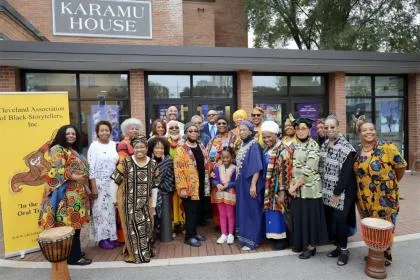 Cleveland Association of Black StorytellersAn oral tradition
Cleveland Association of Black StorytellersAn oral tradition
Since 1995, the 40 members of the Cleveland Association of Black Storytellers In (CABS) have shared their love of regaling listeners with tales in the oral tradition that are at the heart of Black storytelling throughout the African diaspora.
The stories, which span the ages, are filled with heartbreak turning to hope and tragedy, and ultimately leading to triumph.
“Long before the written word was created, each village in Africa had oral historians called griots who used verbal storytelling to portray their cultures and traditions,” explains Michele Rudolph, CABS immediate past president and communications officer.
“It was a role that was handed down in families from generation to generation. The mission of CABS is to pattern ourselves after the original griots; dress in the African tradition; and share cultural, historical, and personal stories.”
In addition to presenting programs year-round at community centers, libraries, and cultural institutions throughout the region, the group participates in special events that celebrate Black History Month, Women’s History Month, and Kwanzaa.
Group members are accompanied by children and teens ages six to 18 who have joined the CABS Kuumba youth storytelling group.
Members meticulously research stories that will resonate with and educate all who hear them. Favorites include works by Eloise Greenfield, an American biographer and poet known for her descriptive, rhythmic style and positive portrayal of the African-American experience; and Virginia Hamilton, a children’s book author and Yellow Springs native.
Rudolph says her favorite folktale is “The People Could Fly,” Hamilton’s fable about Africans captured into slavery and brought to America, where they ultimately were able to wing their way to freedom.
A $5,000 2023 CAC Cultural Heritage Grant helps CABS spread the magic these stories possess by making programs about them possible.
“In these crucial times, it’s important for us to keep tradition alive, tell empowering, historical stories people haven’t heard, and introduce them to heroes they haven’t heard about,” Rudolph says. “We appreciate the support of CAC as we continue our work.”
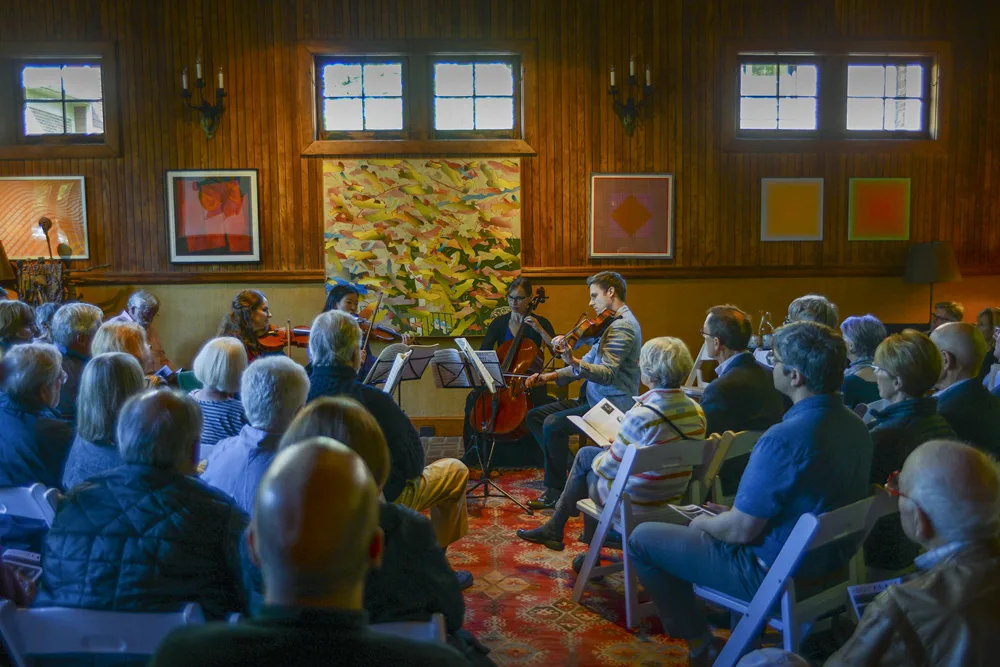 Heights Arts Close Encounters chamber musicArts diversity in the Heights
Heights Arts Close Encounters chamber musicArts diversity in the Heights
It’s easy to see why Cleveland Heights is proud to have claimed the well-deserved moniker “Home to the Arts.” Creativity abounds in the east side suburb.
“Through a visioning process conducted in 2000, it was determined that Cleveland Heights—somewhat due to our proximity to University Circle—is home to one of the largest populations of artists, musicians, and poets who work in the arts,” says Rachel Bernstein, executive director of Heights Arts.
“Heights Arts was born out of the premise that capitalizing on our rich artistic resources would positively impact all aspects of life here, including economic development, education, and creating art in the city.”
The organization presents exhibitions that spotlight works by regional artists and hosts Ekphrastacy evenings where artists discuss their work and a trio of local poets respond with original verse. Through April 2024, the soirees will be hosted by the City of Cleveland Heights’ poet laureate Siaara Freeman.
Additionally, Bernstein says they partner with Heights High School to offer a two-year internship in the student’s junior year to work on the exhibits. “Participants learn all aspects of what’s involved in presenting an exhibition, including choosing artists and writing contracts,” she explains.
Heights Arts also sponsors noteworthy musical performances, including the Close Encounters chamber music series, featuring musicians from the Cleveland Orchestra; locally acclaimed ensembles who perform in stately homes and at historic landmarks in Greater Cleveland; and ARTbar nights, when Heights Arts is transformed into a jazz bar with curated cocktails.
“Close Encounters offer audiences unique venues in which to experience chamber music in a beautiful setting,” Bernstein notes. “And ARTbar offers a bit more diverse programming, other than classical, throughout the year.”
The organization’s devotion to its community includes giving back to local businesses. During the holiday season, Heights Arts’ space becomes a gift shop showcasing work by local artists in a variety of mediums; and in July, the HEART in the Heights fund-raiser focuses on arts awareness.
“When Heights Arts started HEART in the Heights two years ago, 40 businesses participated. Last year, we had 60,” Bernstein says. “Local establishments donate gift certificates, community members purchase raffle tickets for their favorites, and we promote the businesses for the entire month. It’s a mutually beneficial program that elevates awareness, raises money for the arts and gives back to stores in our community.”
A $25,517 CAC General Operating Support Grant helps make Heights Arts’ programming possible.
“Cuyahoga Arts & Culture has a very unique and wonderful way of funding arts organizations,” Bernstein says. “Many times, grants are designated for specific projects. The fact that we receive general operating money to serve our mission in any way we need to is much appreciated.”
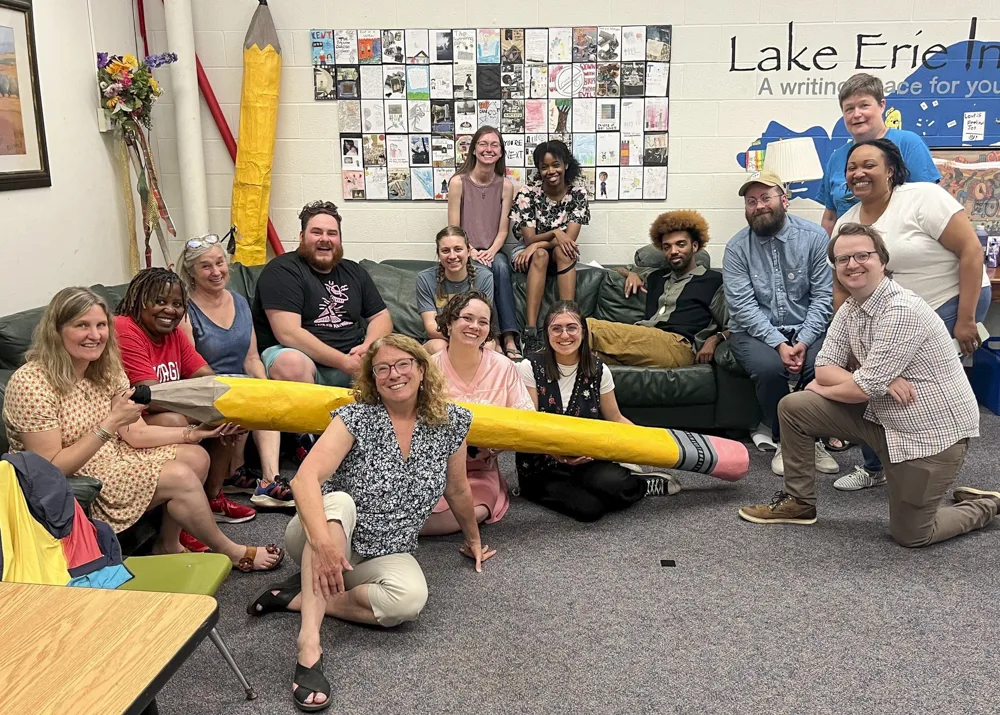 lake_erie_ink_01.JPGYoung expressions
lake_erie_ink_01.JPGYoung expressions
The essays children and teens pen and share with Lake Erie Ink cofounder Amy Rosenbluth tug at her heartstrings. In addition to writing about the normal growing pains Lake Erie Ink students write about subjects ranging from the pressure of ever-increasing academic expectations to climate change to the economic and racial divides their families struggle with.
Rosenbluth, a former high school English teacher who created the Shaker Heights Youth Center’s mentoring program, and secondary-English teacher Cynthia Larsen in 2011 founded Lake Erie Ink—a writing space for youth on the Coventry P.E.A.C.E. campus in Cleveland Heights.
The organization is dedicated to providing artistic opportunities not only for kids and teens who already love writing, but [it’s] also for those young people who have something to say and often feel no one is listening.
“Clearly, students faced a lot of anxiety before the pandemic, but COVID-19 has led to increased social isolation,” Rosenbluth says. “Cynthia and I realized that creative outlets for kids and teens are shrinking. They’re getting smaller and smaller as the problems and the issues of the world are getting larger and larger.”
Rosenbluth serves as Lake Erie Ink’s executive director and Larsen is the education director. With their team, they assist Northeast Ohio teachers in developing programs that served 5,400 students last year.
The Ink Spot, the nonprofit’s creative writing club that meets after school in various locations, provides opportunities for students in third through eighth grades to explore plays, fiction, songwriting, and poetry, as week as craft their own work.
For the organization’s Teen Book Project, teen writers, editors, and designers work with professionals in those respective fields to create an annual anthology. The seventh edition, “Keys & Locks,” was published in June. And the annual Kids’ Comic Con features workshops on storyboarding, drawing, and character creation, along with a cosplay fashion show.
Lake Erie Ink partners with the Maltz Museum Stop the Hate initiative by conducting a series of anti-bias essay-writing programs for students.
“Stop the Hate embodies putting an end to all forms of hate, including homophobia and attacks on the LGBTQ+ community, as well as racism and sexism,” Rosenbluth says. We want to make students aware that it exists and give them the tools to dig deeper about how they should respond when they encounter or experience it.”
“The longer I do this, the more I realize that we adults have a lot to learn from kids,” Rosenbluth reflects. “If we never ask them to share their ideas, or if we do and then never actually listen, we’re missing out.”
A $27,839 CAC General Operating Support Grant helps those goals be realized. Rosenbluth is grateful.
“From the get-go, Cuyahoga Arts & Culture has made it clear that they’re there to support our organization,” she says. “We’re proud to display the CAC logo because it means we’re part of a network in our town that’s supporting the arts.”
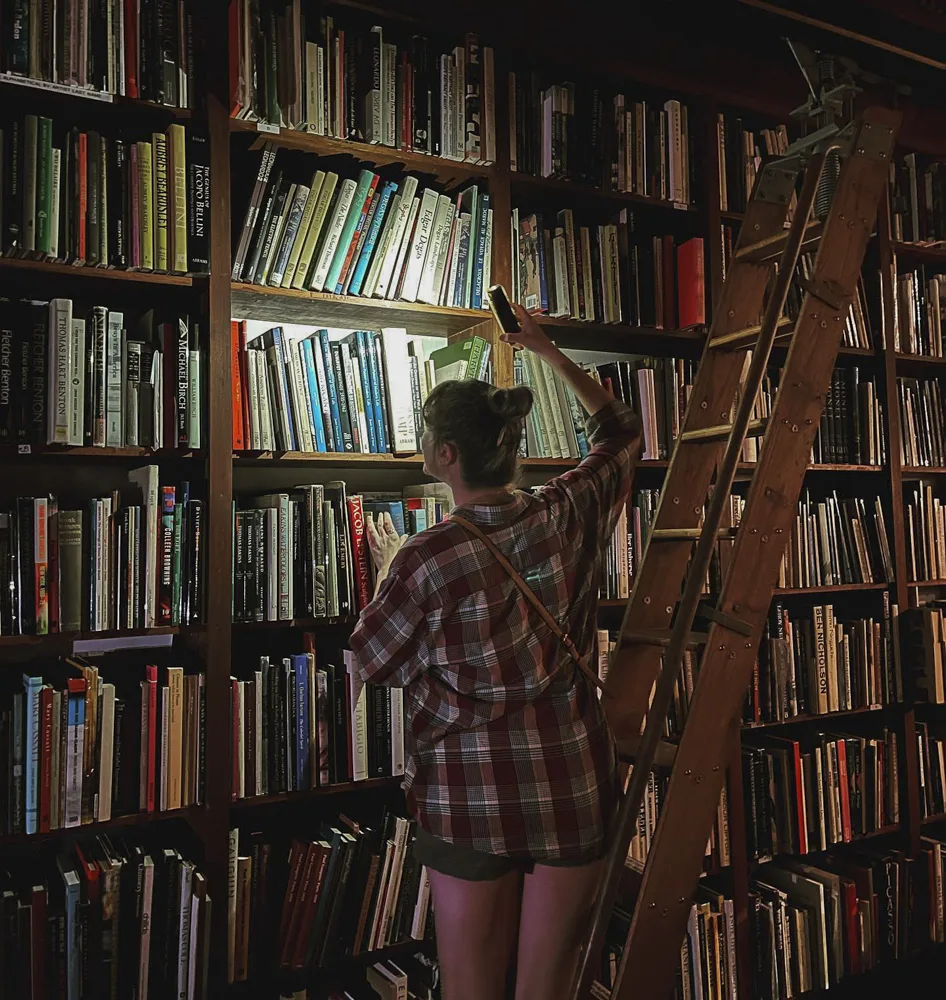 Literary Cleveland After Dark Scavenger Hunt at Loganberry BooksRaising voices
Literary Cleveland After Dark Scavenger Hunt at Loganberry BooksRaising voices
For the 900-plus readers and writers of all skill levels who rely on Literary Cleveland to explore other voices and discover their own, the nonprofit clearly speaks volumes.
“What I hate to hear is when someone says, ‘Literary Cleveland is just for professional writers,’ or when a published author says, ‘That’s just for emerging writers,’” laments executive director Matt Weinkam. “That’s wrong. We’ve created a home for people at both ends of the spectrum because we believe they can help each other.”
Weinkam and his team remain true to that philosophy by staying focused on a mission centered on excellence.
“Northeast Ohio is home to Toni Morrison, Mary Oliver, Langston Hughes and other luminaries who have reshaped our culture and the way we think about ourselves and the world,” Weinkam reflects. “The question is: How can we develop the next great authors who can do the same at our creative writing center?”
Founded in 2015 on Larchmere Boulevard in Shaker Heights, Literary Cleveland’s opportunities abound in multisession workshops, craft talks, annual conferences, and fellowships that provide participants with myriad ways to hone their talents.
Some are tailor-made for those who enjoy writing as an expression of creativity or to experiment with as a hobby. Others are designed for established authors who are seeking support and opportunities that will lead to their published works being promoted on a local or national level.
“Our scholarship programs make all of our classes accessible to everyone, including Northeast Ohioans with limited incomes,” Weinkam says.
He points with pride to Literary Cleveland’s Amplify Projects, which awards fellowships to writers from marginalized groups so they can create a specific projects.
For example, In 2021, Cleveland resident Tisha Carter launched a literary project in response to 2020’s Bloomberg CityLab report citing that Cleveland has the worst outcomes for Black women in the country.
She solicited Black women writers in Northeast Ohio to pen their reactions to those findings, and Literary Cleveland shared their responses by publishing an online anthology with 13 local writers, “Black Women Coping in Cleveland.”
“We’re dedicated to giving the mic and the megaphone to people who have often been silenced,” says Weinkam.
Literary Cleveland’s latest initiative, the Breakthrough Writing Residency, offers six emerging Greater Cleveland writers support and opportunities to help them develop their respective book-length projects.
“Life circumstances can lead to really talented writers falling off track, and a promising voice or project ultimately going into a drawer,” Weinkam says. “To have a mentor by your side to keep encouraging you and help you through tough times is invaluable.”
Thanks to an $18,200 CAC Project Support Grant, the nonprofit can continue developing integrated programs that bring people of all ages, backgrounds, races, and genders together.
“Cuyahoga Arts & Culture has been with Literary Cleveland since we started nine years ago, and their support has helped make our annual Inkubator festival for writers and readers free to everybody,” Weinkam says. “[CAC] encourages nonprofits like ours to be more thoughtful and equitable when it comes to offering programs for everyone. We’re so grateful for the support they’ve provided in helping us move forward.”
As it has for the past five years, the sixth annual Great Lakes African American Writers Conference (GLAAWC) held in September at the Cleveland Public Library (CPL), celebrated literature with meet-and-greets and keynote speakers.
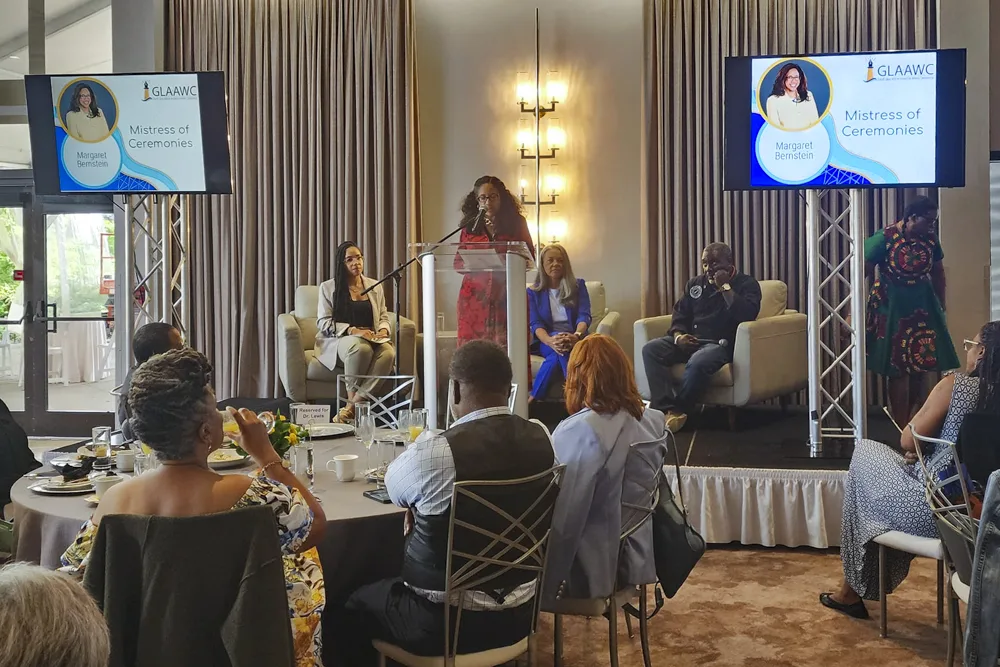 Great Lakes African American Writers ConferenceOvercoming inequities
Great Lakes African American Writers ConferenceOvercoming inequities
Developed by Little Lumpy’s Center for Educational Initiatives in the Larchmere neighborhood, more than 350 authors, playwrights, entrepreneurs, professors, and business executives registered for this year’s GLAAWC event with the theme, “Black Books, Black Business, Black Excellence.”
“GLAAWC is an ideal forum for professionals in those fields to get together, share stories and get the advice they need to succeed,” says Little Lumpy’s executive director Rev. Dr. Leah Lewis, who founded the organization in 2017.
The organization’s name is taken from Lewis’ “Little Lumpy’s Book of Blessings,” which she published in 2001 to impart an “attitude of gratitude” to all who read it.
“GLAAWC’s mission has always been to eliminate knowledge deficits for writers, and that goal remains,” she says of the September conference. “Whether it’s the process of writing or the business of publishing, the conference is always a source of insight.”
A $13,094 CAC Project Support Grant helped make the event flourish in 2023.
“Cuyahoga Arts & Culture has been our day-ones,” Lewis says. “Their support, along with that given by the Cleveland Foundation, has been essential in helping the conference grow and not lead to a deficit.”
Little Lumpy’s future initiatives include launching a Pre-K Literacy Readiness Program to combat statistics indicating that 66% of Cleveland residents are functionally illiterate, and an Animated CLE Workforce Development Program in partnership with CPL and the Canadian software company Toon Boom.
“We’re striving to grow so we can overcome the historic challenge of inequity we face as a nonprofit founded by an African American woman in one of the poorest big cities in the nation,” Lewis says.
The program is set to begin in 2024 with the goal of teaching Northeast Ohioans the skills they need for jobs in animation, computer and digital fields.


